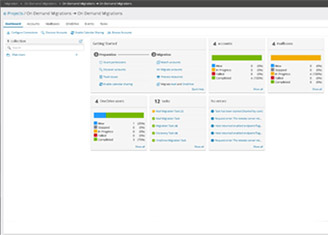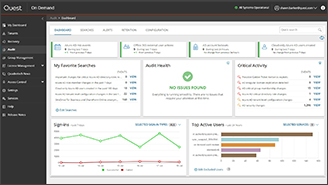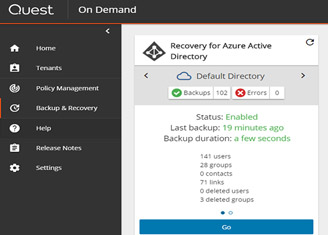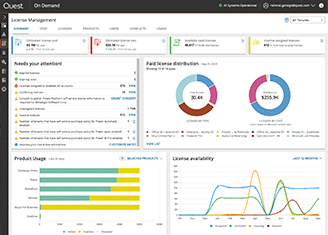-
Resources
- Forums
-
Quest dramatically reduces gotomarket times with Azure

For us, consolidating our 78 disparate labs into a single Azure platform has improved operations, helped us reduce costs, and increased our agility, both in terms of platform management and go-to-market times.
For more than 30 years, Quest Software has aided businesses in their journey to simplify IT management, spend less time on IT administration, and devote more time to innovation. As part of an internal move to Microsoft Azure, Quest also developed a series of software as a service offerings for its customers, resulting in stronger relationships with existing customers, multiple new avenues for growth, and the agility to bring new services to market 66 percent faster than it could in the past.
Since 1987, Quest Software has helped companies large and small navigate the ever-changing technologies that empower the global economy. A worldwide provider of software, solutions, and services to more than 130,000 companies in 100 countries, Quest is a billion-dollar technology company and has been a top-ranked member of the Microsoft Partner Network for the past 16 years. During its 30-plus years of history, Quest has taken part in every major technological shift since the advent of the internet.
“We’ve grown a lot over the years,” says Thomas Wismer, Senior Manager of Operations Services at Quest. “And, like many larger companies, a lot of that growth was through acquisitions. A few years ago, Quest was operating 78 offices globally, each of which was provisioned with its own on-premises infrastructure. As cloud-based infrastructure solutions such as Microsoft Azure became available, we saw the opportunity to transform not only its customer-facing offerings, but our own infrastructure to best take advantage of the benefits of cloud computing.”
“Migrating to Azure, we consolidated our disparate labs into a single global hub,” says Wismer. “The move has paid enormous dividends. Operationally, we no longer have to procure, deploy, and manage a highly secure infrastructure across multiple offices, and we’ve become much more agile in terms of how we’re able to manage our platform.”
The benefits of the cloud
Quest’s move to the cloud has been focused on more than internal operations. “When you look at the products we traditionally sell, they’re tailored to function as on-premises software,” says Michael Tweddle, President and General Manager of Platform Management at Quest. “In developing our newest services, we’ve taken a very similar approach to that of Microsoft, offering cloud-based services that will aid our customers as they make their own transitions to hybrid and cloud-only infrastructures.”
The company elected to use Azure as the basis of its software as a service offering, Quest On Demand, so it could quickly adopt new Azure features and functionalities as they are released. “We’re taking advantage of technology built by Microsoft and released within Azure in order to go to market faster than we could on our own,” says Tweddle. “On average, over the last three years of consuming Azure services, we’ve been able to get new capabilities to market 66 percent faster than we could in the past.”
Hosted on Azure, the Quest On Demand platform offers modules for migrations, audits, recovery, group management, and license management. It uses multiple Azure resources to deliver easy onboarding and configuration, multiple tenant management with role-based access and single sign-on capabilities, flexible licensing, automated updates, new features and security upgrades.
Reliability, uninterrupted access, and a lot of insight
To deliver worldwide reliability and support for DevOps teams across North America, Europe, and Asia, Quest deployed Quest On Demand production and disaster recovery environments across multiple Azure regions in Australia, Canada, Europe, the United Kingdom, and the United States. The company uses Azure App Service to host microservices in Azure Functions. These support user capabilities such as registering new tenants and also application functionality like communicating with other microservices or other Azure platform resources such as the Azure Cosmos DB managed NoSQL database service.
Quest uses Azure API Management primarily as an API gateway for the Quest On Demand microservices that implement business logic with Azure Functions and to apply policies that control access, traffic, and security across microservices. With API Management, the company publishes API documentation for DevOps teams and issues separate subscriptions for each client. Using an API Management custom domain, Quest can isolate public endpoints and redeploy API Management instances to different environments or locations if needed.
Quest on Demand customers use these Azure resources to migrate Azure Active Directory (Azure AD) accounts, Exchange Online mailboxes, and SharePoint Online sites from one tenant to another without setting up new servers. Post-migration, they can restore accidentally or maliciously deleted Azure AD accounts quickly, with no access interruption and without losing critical configurations like multifactor authorization. On Demand Recovery works hand in hand with on-premises Active Directory recovery solutions and Azure Active Directory Connect to restore all of the users’ cloud-specific attributes and permissions. Quest also leverages Microsoft Graph to provide hybrid auditing of Azure AD and Microsoft 365. Using it in conjunction with Quest Change Auditor gives users one interface to view critical changes to their Microsoft cloud and on-premises workloads.
“Just as we’ve facilitated the move to the cloud for our customers, we’ve been on a similar journey of adoption ourselves,” says Tweddle. “Solutions such as Azure Active Directory, Exchange, OneDrive, SharePoint, and most recently Teams are all important parts of our platform. And since we’re such heavy users of Azure and Microsoft 365 ourselves, we have a lot of insight into how our own customers might want to use these same offerings.”
A more agile workplace—for everybody
To promote more agile work-from-home strategies, Quest adopted Microsoft Teams for its unified communication and collaboration platform, which combines persistent workplace chat, video meetings, file storage, and application integration. “By using Teams to support our own remote workforce, we ended up creating use cases that were authentic and relevant to situations our customers face,” says Steven Phillips, Senior Director of Marketing for the Microsoft Platform Management Business Unit at Quest. “Through real-time collaboration in Teams, we pushed solutions into the market that matter now.”
Now Quest uses Teams to host impromptu meetings several times a day, whenever employees have free time, to focus on shifts in customer needs and accelerate time to value for customer solutions. “With Teams, I’m now in meetings that function as relationship-building experiences,” says Leigh Ann Campbell, Director of Alliances at Quest. “Seeing people’s fun backdrops, sharing content live, and really being face-to-face with everyone—our customers included—has lent itself to supporting each other and creating value together.”
A better tomorrow
Whether they’re helping their customers move to the cloud or helping a business set up and begin using Teams, the professionals at Quest are constantly adapting their own use of Microsoft technology to meet the changing needs of the marketplace. “Since adopting Azure, we’ve actually seen an increase in our customer base and have been able to help a number of new companies while retaining the customers we have,” says Tweddle. “By innovating this way, we’ve been able to strengthen those existing relationships.”
The next innovation on Quest’s roadmap focuses on AI and machine learning. “We’re often asked to apply AI to the data we collect during change tracking in order to look for anomalous behavior and potential internal or external threats,” says Tweddle. “We’re working with Microsoft on a solution that can help us to develop services that use Azure Advanced Threat Protection to deliver new security layers to our customers.”
This move into AI workloads represents a new avenue for growth at Quest that will bolster the already successful Quest On Demand platform. With more than 1,500 Quest On Demand customers, Quest predicts that Azure and cloud-based productivity will become increasingly commonplace for the majority of businesses.
“For us, consolidating our 78 disparate labs into a single Azure platform has improved operations, helped us reduce costs, and increased our agility, both in terms of platform management and go-to-market times,” says Wismer. “At a minimum, we want to see our customers realize those same benefits of migrating to the cloud, and we’re working very hard every day to make sure that they also gain the productivity, advanced security, and collaboration that will allow us all to master today’s unique challenges.”
Find out more about Quest on Twitter, Facebook, YouTube, and LinkedIn.
We’re taking advantage of technology built by Microsoft and released within Azure in order to go to market faster than we could on our own. On average, over the last three years of consuming Azure services, we’ve been able to get new capabilities to market 66 percent faster than we could in the past.
Since adopting Azure, we’ve actually seen an increase in our customer base and have been able to help a number of new companies while retaining the customers we have. By innovating this way, we’ve been able to strengthen those existing relationships.




